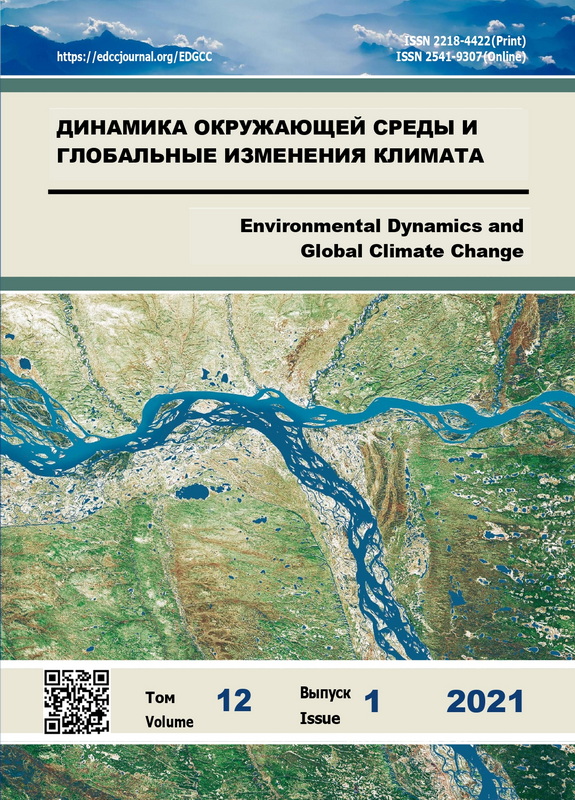Том 12, № 1 (2021)
- Год: 2021
- Выпуск опубликован: 16.07.2021
- Статей: 4
- URL: https://edgccjournal.org/EDGCC/issue/view/4068
Экспериментальные работы
Application of the automated chamber method for longterm measurements CO2 and CH4 fluxes from wetland ecosystems of the West Siberia
Аннотация
Автоматизированные камерные системы, работающие в закрытом динамическом режиме, рекомендованы в качестве основного метода для измерений потоков парниковых газов на границе почва – атмосфера для станций входящих в систему ICOS (Integrated Carbon Observation System). В работе приводятся данные измерений сезонных потоков метана (CH4) и углекислого газа (CO2) в характерных растительных ассоциациях на Бакчарском болоте в Томской области в теплое время 2014 – 2019 гг. с использованием автоматического камерного комплекса «Flux-NIES». Обсуждается межгодовая и пространственная изменчивость поглощения атмосферного углерода болотной растительностью и его эмиссии из торфяной залежи. Наблюдается связь этих процессов с уровнем увлажнения в болотных экосистемах.
 5-14
5-14


Natural features of the orchid refugium on the territory of the natural park “Samarovsky chugas
Аннотация
В статье рассматриваются природные условия и биологические ресурсы, ландшафтные особенности ключевой территории природного парка «Самаровский чугас»», расположенного в черте города Ханты-Мансийска. Дается обзор географических исследований данного региона. Характеризуются основные компоненты, влияющие на формирование природных комплексов особо охраняемой природной территории. Особое внимание уделяется характеристике растительности и процессам антропогенного изменения ландшафтов данного ключевого участка. Выделяются основные пути трансформации растительности, вызванные хозяйственной деятельностью, изменением характера поверхностного стока. Характеризуются эколого-географические условия рефугиума орхидных. Обосновывается необходимость выделения исследуемого участка в качестве зоны с заповедным режимом в пределах территории природного парка.
 15-26
15-26


Biogeochemical assessment of the main plants at the Nadym district's reindeer pastures (Yamal-Nenets autonomous okrug)
Аннотация
На фоновых участках нефтегазоносных районов севера Западной Сибири в пределах северной тайги, лесотундры и южной тундры изучен элементный состав широко распространенных модельных видов древесных пород (Betula pubescens, Larix sibirica, Pinus sylvestris, Salix lanata), кустарничков (Vaccinium vitis-idaea, Ledum palustre s. l.),трав(Eriophorum angustifolium, Equisetum arvense) илишайников (Cladonia stellaris, Cladonia stygia). Приведены данные о содержании Cr, Co, Ni, Cu, Zn, Ga, As, Y, V, Na, Mg, Si, P, S, K, Ca, Ti, Mn, Fe, S, полученные с использованием метода рентгенофлуоресцентного энергодисперсионного анализа.
Выявлены особенности локального биогеохимического фона растений, изучена их видовая геохимическая специализация. Наибольшее различие уровня аккумуляции между разными видами растений обнаружено для Ni, Zn, Ca, Mn, S и Si. Проведен анализ коэффициентов концентрации химических элементов в растениях относительно локального фонового уровня. Статистические достоверные различия в накоплении элементов растениями в разных биоклиматических зонах выявлены для Cu, Fe, Co, Cr, As, Mg, V, Y.
Изученные растения по критериям экологической безопасности и содержанию нормируемых микро- и макроэлементов в основном соответствуют требованиям, предъявляемым к кормовым растениям. Исключение составляет низкий уровень содержаний биогенных элементов Co, Na и К. Для профилактики заболеваний животных, связанных с дефицитом эссенциальных элементов, необходимо оптимизировать рацион питания оленей путём обогащения кормов биологически активными веществами и макро- и микроэлементами.
 27-42
27-42


Дискуссии
Impact of snow cover and air temperature on ground freezing depth and stability in mountain are
Аннотация
Поскольку при строительстве селе- и лавиноудерживающих геотехнических сооружений на горных территориях возникает проблема крепления и устойчивости этих сооружений в условиях сезонного и/или многолетнего промерзания грунта, в данной работе производится оценка влияния снежного покрова и температуры воздуха на глубину промерзания и устойчивость грунта на основе разработанной расчётной схемы за зимние сезоны 2015/16-2019/20 в Приэльбрусье. Расчётная схема строилась на основе задачи теплопроводности трехслойной среды (снег, мерзлый и талый грунт) с фазовым переходом на границе. Уравнение теплового баланса включало энергию фазового перехода, приток тепла из талого грунта и отток в мерзлый грунт и при наличии снежного покрова через него в атмосферу.
Ключевые слова: Снежный покров, температура воздуха, промерзание
 43-46
43-46











